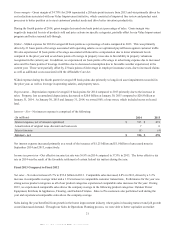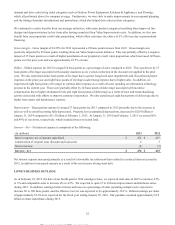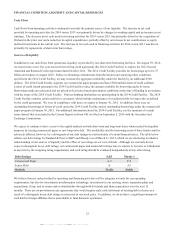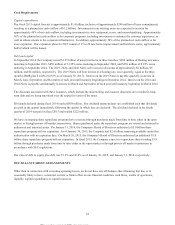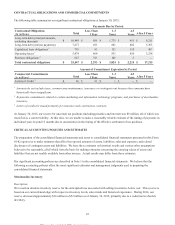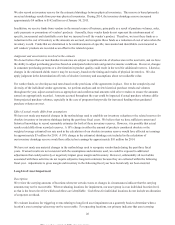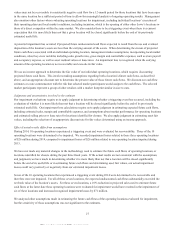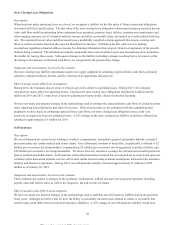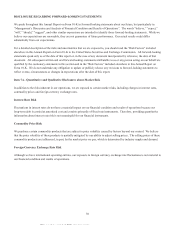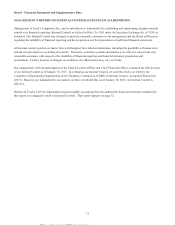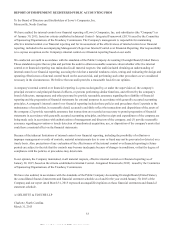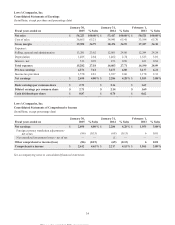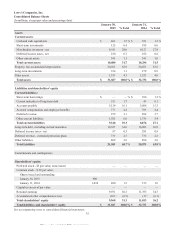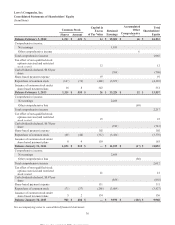Lowe's 2014 Annual Report Download - page 38
Download and view the complete annual report
Please find page 38 of the 2014 Lowe's annual report below. You can navigate through the pages in the report by either clicking on the pages listed below, or by using the keyword search tool below to find specific information within the annual report.Store Closing Lease Obligations
Description
When locations under operating leases are closed, we recognize a liability for the fair value of future contractual obligations
associated with the leased location. The fair value of the store closing lease obligation is determined using an expected present
value cash flow model incorporating future minimum lease payments, property taxes, utilities, common area maintenance and
other ongoing expenses, net of estimated sublease income and other recoverable items, discounted at a credit-adjusted risk free
rate. The expected present value cash flow model uses a probability weighted scenario approach that assigns varying cash
flows to certain scenarios based on the expected likelihood of outcomes. Estimating the fair value involves making
assumptions regarding estimated sublease income by obtaining information from property brokers or appraisers in the specific
markets being evaluated. The information includes comparable lease rates of similar assets and assumptions about demand in
the market for leasing these assets. Subsequent changes to the liability, including a change resulting from a revision to either
the timing or the amount of estimated cash flows, are recognized in the period of the change.
Judgments and uncertainties involved in the estimate
Our store closing lease liability calculations require us to apply judgment in estimating expected future cash flows, primarily
related to estimated sublease income, and the selection of an appropriate discount rate.
Effect if actual results differ from assumptions
During 2014, the Company did not close or relocate any stores subject to operating leases. During 2013, the Company
relocated two stores subject to operating leases. Expenses for store closing lease obligations included $12 million and $6
million in 2014 and 2013, respectively, related to adjustments for previously closed or relocated locations.
We have not made any material changes in the methodology used to estimate the expected future cash flows of closed locations
under operating leases during the past three fiscal years. If the actual results are not consistent with the assumptions and
judgments we have made in estimating expected future cash flows, our store closing lease obligation losses could vary
positively or negatively from our estimated losses. A 10% change in the store closing lease liability would have affected net
earnings by approximately $3 million for 2014.
Self-Insurance
Description
We are self-insured for certain losses relating to workers’ compensation; automobile; general and product liability; extended
protection plan; and certain medical and dental claims. Our self-insured retention or deductible, as applicable, is limited to $2
million per occurrence involving workers’ compensation, $5 million per occurrence involving general or product liability, and
$10 million per occurrence involving automobile. We do not have any insurance coverage for self-insured extended protection
plan or medical and dental claims. Self-insurance claims filed and claims incurred but not reported are accrued based upon our
estimates of the discounted ultimate cost for self-insured claims incurred using actuarial assumptions followed in the insurance
industry and historical experience. During 2014, our self-insurance liability increased approximately $1 million to $905
million as of January 30, 2015.
Judgments and uncertainties involved in the estimate
These estimates are subject to changes in the regulatory environment; utilized discount rate; projected exposures including
payroll, sales and vehicle units; as well as the frequency, lag and severity of claims.
Effect if actual results differ from assumptions
We have not made any material changes in the methodology used to establish our self-insurance liability during the past three
fiscal years. Although we believe that we have the ability to reasonably estimate losses related to claims, it is possible that
actual results could differ from recorded self-insurance liabilities. A 10% change in our self-insurance liability would have
28
This proof is printed at 96% of original size
This line represents final trim and will not print





